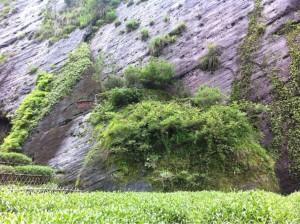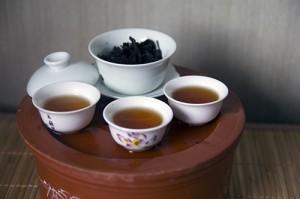1 of the best known and most highly regarded Chinese teas is Dahongpao (大红袍) or commonly translated as Big Red Robe.
As with historical teas in China with fanciful names, you would expect legends behind Dahongpao. According to Zhong Guo Cha Jing 2011, there are 3 versions, 2 of which involve deities and fairies, certainly no point in pondering if there occurred.
However, the well-known tale of a “Grateful Scholar” (状元报恩) is worth another look. Unfortunately as with the case of Shen Nong and the first leaf, accounts get increasingly fanciful depending on whom you ask but the gist of it is as follows:
Once upon a time, there was a scholar who was rushing on his way to the capital for the Imperial Examinations. As he passed by the foot of Wuyishan, he fainted. The abbot of Tianxin Temple brought him back and nursed him back to health with some tea.

When he left the temple recharged and brimming with confidence, he promised the abbot that should he gain fame and fortune, he would return and show his gratitude.
As you would expect from legends, the said scholar did exceptionally well, being named “zhuang yuan” (状元) or the best scholar of the batch.
With that, the poor scholar was fast tracked for success but he never forgot his promise to the abbot. He returned to Wuyishan at the first possible moment and begged the abbot to share the divine tea that nursed him back to health.
The abbot had some of his monks pick the leaves, processed it and gave it to the scholar. Like the loyal subject (ass kisser for the cynical) he was, the scholar’s first thought upon his return to the capital was to share it with the Emperor.
The Emperor was blown away by the tea and remarked “You are a Zhuang Yuan (Top Scholar) among men and this is a Zhuang Yuan among teas! Since it is a Zhuang Yuan, it should be given a red robe, just like you.”
Hence, the tea became known after the robe that was bestowed by the Emperor.
In various versions of this story it has the Dowager Empress being cured or the Emperor being cured. Some fanciful versions have it that the robe was draped on the trees and they started taking on hues of red and such.
Did this Happen?
Certain fantastic elements of the tale are unlikely to occur- the near supernatural curative prowess of the tea for one. And if one’s mother was near death, I doubt anyone would be so cavalier in experimenting with unauthenticated remedies.
However, some parts of the tale do check out.
Let’s look at the color red; or more precisely, big red (大红) which is often known in Mandarin as “China Red” (中国红).
If you want to be technical:
RGB: R230, G0, B0
This is traditionally a favored color of the Chinese. In Chinese feudalistic eras, yellow is the color of royalty and the sole prerogative of the monarchs but red, more precisely “China Red” was the color that monarchs used to show favor to their subjects, especially during the Han and Ming Dynasties.
Hence the “Da Hong” seems to be congruent with the story.
Timing
The fact that Dahongpao was the earliest known documentation of Dahongpao was found around the middle of the 17th century doesn’t help us in establishing a case either way though.
The Ming Dynasty ended in 1644 and while the Imperial Examinations were re-established in 1646, at that time, the segregation between the Manchu (the ethnicity of the rulers of the Qing Dynasty) and the Han (majority ethnic group of Chinese) was still obvious.
If Dahongpao first originated around 1644-1700, we can be quite certain this tale is false:
Since the scholar passed Wuiyshan on his way to Beijing, he should be of Southern Chinese descent and most likely Han, if not one of the minority tribes other than Manchurian.
It would have been unlikely in the social strata of that era that a Han would be named Zhuang Yuan and be admitted into the highest echelon of the civil service- that would have been after Emperor Qian Long’s era.
Unfortunately, we can’t draw any conclusions from the era.
The Modern Legend

This is a subject of contention on Teachat and it was disputed if it ever happened.
It did seemed unlikely to me that Richard Nixon could commit a faux pas by sneering at a gift from a nation’s leader but then I read an account of this in Lin Zhi’s “Hua Shuo Da Hong Pao” that made it more plausible.
Prior to meeting with Chairman Mao, Premier Zhou En Lai- the number 2 man in the party- had already met up with Nixon and had gifted him a few kilograms of Xihu Longjing.
As Zhou’s superior, Mao had to give Nixon a present of at least matching stature but as tea lovers know, Xihu Longjing is considered the premium Chinese tea. It would appear unbecoming of Mao to give Nixon more Longjing but if he had given Nixon a tea of lesser stature, it would not reflect well on him.
Upon careful pondering, he felt only the Dahongpao from the mother tree was of equal stature and he gave Nixon 200g of Dahongpao, which was approximately equal to half of the annual harvest from the tree.
Nixon’s then asked Zhou “why is it that you gave me a few kilograms of tea but Chairman Mao only gave me 200g”. An entirely fair question in those circumstances in my opinion.
While we may never know conclusively if it happened- in my opinion stenographers would have considered it too minor a detail to record- this version does make it a great deal more plausible than a brash Nixon.
In any case, the argument that this story was concocted to boost the value of Dahongpao doesn’t really hold water since Dahongpao from the mother tree is highly regarded, with or without this tale.
The Urban Legend
I know of people who know people who claim to have tasted the Dahongpao from the original mother tree.
This is one legend that is easily debunked.
Since 1920s, the mother tree was closely guarded and the property of the ruling party. It hardly ever appears on the open market and here are the recent public auctions:
Date Location Price of 20g Buyer
18/08/1998 Wuyishan 156,800 RMB (~ SGD 31,360) Xu Rong Mao from Macau
25/11/2008 Guangzhou 180,000 RMB (~SGD 36,000) Guangzhou Nanhai Fishing Village
Dec 2004 Hong Kong 166,000 RMB (~SGD 33,200) Jiang Xiao Hong
13/04/2005 Shanghai 198,000 RMB (~ SGD 39,600) Ma Wu (Beijing)
17/4/2005 Wuyishan 208,000 RMB (~SGD 41,600) Chen Han Ming (Singapore)
Source: Wuyishan Cha Jing pg 758
Assuming you use 7g per serving, dividing it by 3, it means a serving is still worth $10k SGD at least.
Whoever tells you they have tasted it, well…. I suppose you can draw your own conclusion.
Now Dahongpao from the non-mother tree may not be worth THAT much but it’s still worth a pretty penny and we will talk about it later.
See here for other articles related to varieties of oolong tea.
Dahongpao will be among the teas launched in our upcoming Oolong Tea Workshop.
